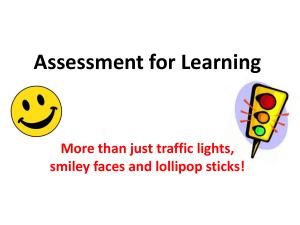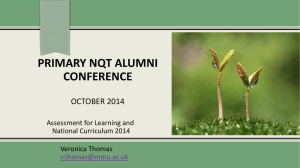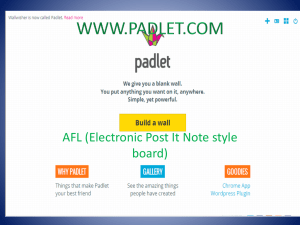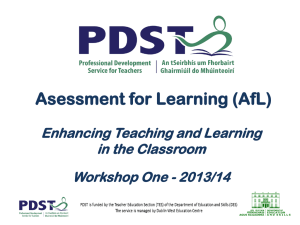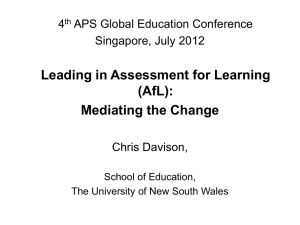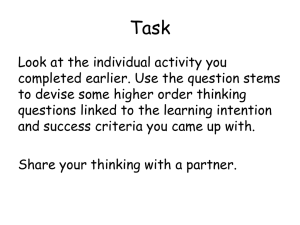Skill 06_ Using assessment for learning
advertisement
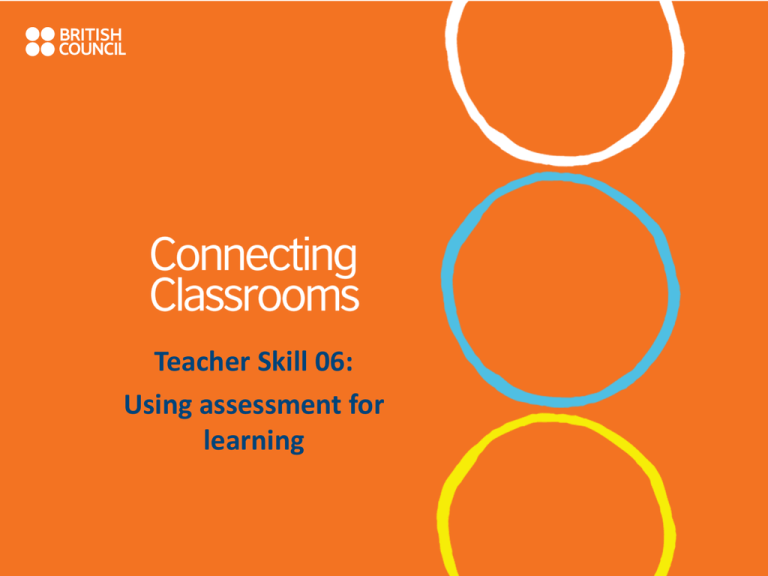
Teacher Skill 06: Using assessment for learning Teacher Skill 06: Using assessment for learning OBJECTIVES 1. 2. 3. 4. 5. What is (AfL)? Why bother with AfL? How do I use AfL? Challenges in bringing in AfL What are the possibilities in using AfL? 1. What is (AfL)? “Inside the black box” Paul Black and Dylan Wiliam. Assessment for Learning is also called formative assessment. Here “assessment” refers to all those activities undertaken by teachers, and by their students in assessing themselves, which provide information to be used as feedback to modify the teaching and learning activities in which they are engaged. Such assessment becomes “formative assessment” when the evidence is actually used to adapt the teaching work to meet the needs. 1. What is (AfL)? There are several purposes to formative assessment: • to provide feedback for teachers to modify subsequent learning activities and experiences; • to identify and remediate group or individual deficiencies; • to move focus away from achieving grades and onto learning processes, in order to increase self efficacy and reduce the negative impact of extrinsic motivation; • to improve students' metacognitive awareness of how they learn. Wikipedia • "frequent, ongoing assessment allows both for http://en.wikipedia.org/ fine-tuning of instruction and student focus on wiki/Formative_assessm progress." ent 2. Why bother with AfL? 1. Because of the results it produces. Research studies show that formative assessment produces significant, and often substantial, learning gains. Also studies show that improved formative assessment helps the (so-called) low attainers (and students with learning disabilities) more than the rest, and so reduces the spread of attainment whilst also raising it overall. 2. Why bother with AfL? 2. Because of the impact on self-esteem. Pupils who encounter difficulties and poor results are led to believe that they lack ability, and this belief leads them to attribute their difficulties to a defect in themselves about which they cannot do a great deal. Feedback to any pupil should be about the particular qualities of his or her work, with advice on what he or she can do to improve, and should avoid comparisons with other pupils. 3. How do I use AfL? 1. Self-assessment by pupils Self-assessment by pupils, far from being a luxury, is in fact an essential component of formative assessment. For formative assessment to be productive, pupils should be trained in self-assessment so that they can understand the main purposes of their learning and thereby grasp what they need to do to achieve. 3. How do I use AfL? 2. Opportunities for pupils to express their understanding should be designed into any piece of teaching, for this will initiate the interaction whereby formative assessment aids learning. 3. How do I use AfL? 3. To begin at the beginning, the choice of tasks for class and homework is important. Tasks have to be justified in terms of the learning aims that they serve, and they can only work well if opportunities for pupils to communicate their evolving understanding are built into the planning. 3. How do I use AfL? 4. Asking effective questions 3. What are the details of AfL? 5. Effective testing 4. Challenges in bringing in AfL (And Q1) 1. Shifting beliefs in a school concerning: 1. 2. 3. What effective teaching is The purpose of giving feedback The managerial imperative 4. Challenges in bringing in AfL 2. Some pupils will resist attempts to change accustomed routines, for any such change is threatening, and emphasis on the challenge to think for yourself (and not just work harder) can be disturbing to many. 4. Challenges in bringing in AfL 3. Giving it the time needed. 4. Challenges in bringing in AfL 4. Changing teacher beliefs 1. The nature of each teacher's beliefs about learning. 2. The beliefs that teachers hold about the potential to learn of all of their pupils. The evolution of effective teaching Opportunities for pupils to express their understanding should be designed into any piece of teaching, for this will initiate the interaction whereby formative assessment aids learning. The dialogue between pupils and a teacher should be thoughtful, reflective, focused to evoke and explore understanding, and conducted so that all pupils have an opportunity to think and to express their ideas. Benefits of AfL for Teachers Benefits of Formative Assessments for Teachers (Boston, 2002) 1. Teachers are able to determine what standards students already know and to what degree. 2. Teachers can decide what minor modifications or major changes in instruction they need to make so that all students can succeed in upcoming instruction and on subsequent assessments. 3. Teachers can create appropriate lessons and activities for groups of learners or individual students. 4. Teachers can inform students about their current progress in order to help them set goals for improvement. Benefits of AfL for Students Benefits of Formative Assessments for Students 1. 2. 3. 4. Students are more motivated to learn. Students take responsibility for their own learning. Students can become users of assessment alongside the teacher. Students learn valuable lifelong skills such as self-evaluation, selfassessment, and goal setting. 5. Student achievement can improve. 5. What are the possibilities in using AfL? (And Q2) The Assessment Reform Group has set out 10 principles for formative assessment. These are that assessment for learning should: 1. 2. 3. 4. 5. be part of effective planning of teaching and learning focus on how students learn be recognised as central to classroom practice be regarded as a key professional skill for teachers be sensitive and constructive because any assessment has an emotional impact 6. take account of the importance of learner motivation 7. promote commitment to learning goals and a shared understanding of the criteria by which they are assessed 8. enable learners to receive constructive guidance about how to improve 9. develop learners’ capacity for self-assessment so that they can become reflective and self-managing 10. recognise the full range of achievements of all learners Activity 1 The thumb exercise Plenary What action will you now take based on what you have learnt from Teacher Skill 6?
![afl_mat[1]](http://s2.studylib.net/store/data/005387843_1-8371eaaba182de7da429cb4369cd28fc-300x300.png)
